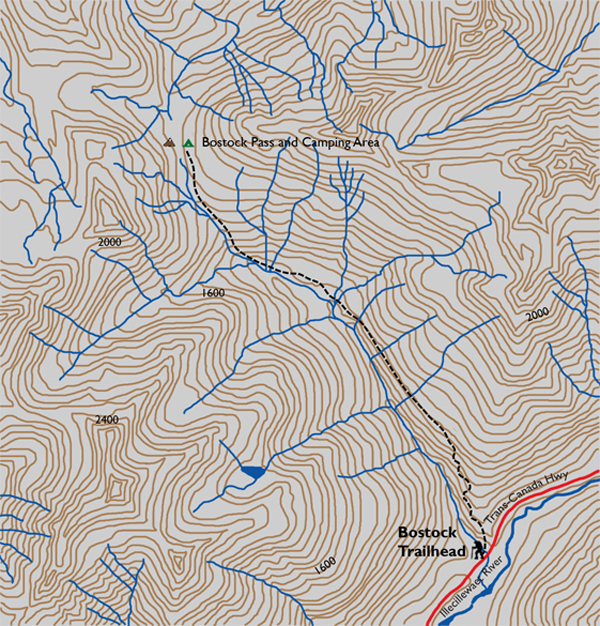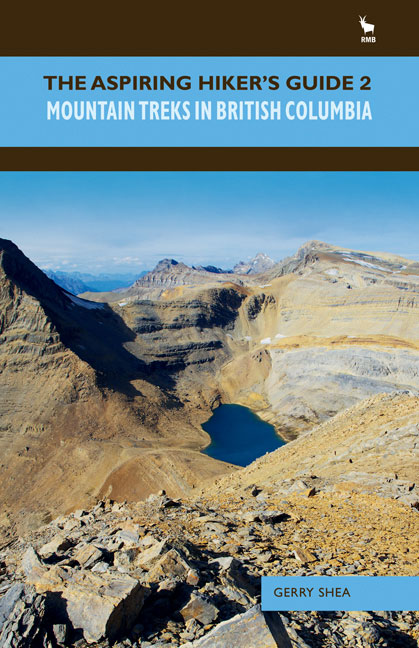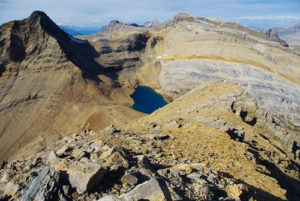Distance
Gradually, the trail ascends through small clearings containing thigh-deep brush that can and will scrape up your legs if you are not properly clothed. Hiking shorts are not recommended. On a cloudless day, the clearings and crossings can reveal abundant views of neighbouring peaks, with Mount Fidelity, Corbin Peak and Mount McGill figuring prominently among them.
The forest begins the characteristic thinning of a trail approaching the subalpine zone. As the route continues its upward winding journey, the transition to subalpine is subtle yet noticeable. Continue the upward trek, and in due course the path emerges from subalpine forest to the expanse of the upper meadow at Bostock Pass.
This unique meadow is dotted with islands of trees because it lies in the subalpine and not completely above the treeline. Still, the trees are not thick enough or clumped close enough together to constrain your view of the surrounding mountaintops.
Bostock history
In 1896, Caribou Creek, pass and valley were renamed in honour of British-born Canadian Senator Hewitt Bostock. At one time, an abundance of mountain caribou populated this pass, but since their numbers had significantly dwindled by then, the original name seemed inappropriate, and the uncommon practice of renaming encountered no opposition. Bostock’s careers were varied and abundant, as he excelled at logging, printing, politics, mining, real estate, fruit farming and ranching.
Hewitt Bostock was born in Walton Heath, Surrey, on May 31, 1864. He attended Trinity College in Cambridge from 1882 to 1885, earning a degree in mathematics. After obtaining his Masters in 1890, he was called to the bar in 1888, but he never practised law. Bostock’s first visit to Canada was in 1886 to see Ottawa and the Parliament buildings, but it was during a later excursion while touring North America, China and Japan, that he visited the Kamloops, BC, region, where he purchased a ranch, as a retreat, at present-day Monte Creek in 1888. In 1893, he and his wife, Lizzie, moved to Victoria, BC, and visited the ranch only periodically for holidays.
The next few years were fast paced and quite busy for Bostock. Around 1893 or ’94, he started the Kootenay Lumber Company, establishing the prosperous sawmill town called Comaplix, on the northeast arm of Upper Arrow Lake at the mouth of the Incomappleux River. He established a weekly newspaper, The Province, in Victoria in 1894. Four years later, under pressure from business associates, he moved his presses to Vancouver and established a daily, also called The Province, which still exists today.
Bostock’s political career began when he and his family established roots back in Monte Creek in 1894. The 1896 federal election saw Bostock run successfully for the Liberals in Yale–Cariboo. He was appointed to the Senate in 1904. In 1914 he became the Liberal party leader in the upper house, and in 1921 he was named speaker of the Senate.
During the span between 1898 and 1900, Bostock constructed at least two business blocks on the main street of Kamloops and became president of the Tranquille Creek Hydraulic & Quartz Mining Co. Ltd.
This extremely busy man died of uremia in 1930. He was buried on the property in Monte Creek alongside the small church he built in 1926, which still stands today. The church is visible from the Monte Creek interchange on the northeast side of the Hwy. 97 on-ramp to the Trans-Canada Highway. Mount Hewitt Bostock is in the Cascade Range, just 20 km northeast of the village of Boston Bar, BC, in what formerly was the Yale–Cariboo riding where he was first elected MP in 1896.
Directions
Take the Trans-Canada Highway to 19.5 km west from the Rogers Pass Centre and 50.5 km east of the town of Revelstoke, BC. The parking area is on the north side of the highway and well marked.
The path begins by crossing to the east side of Bostock Creek just as you’re leaving the parking lot. It then enters a humid, dark-green Interior rainforest of Engelmann spruce and western hemlock with ferns, mosses and lupines. An uphill climb of switchbacks begins as you enter the forest and continues until the creek is a substantial distance below. The trail continues to climb along a steep, treed hillside with little room to manoeuvre. If you look carefully to the left (west) you may see the hut of the Christiana snow research station perched on Christiana Ridge on the easterly rise of Mount Fidelity.






